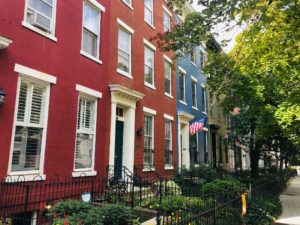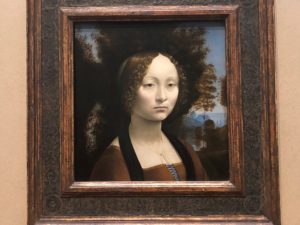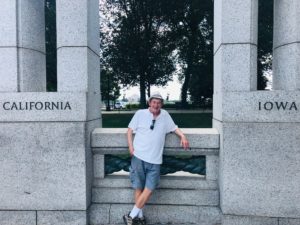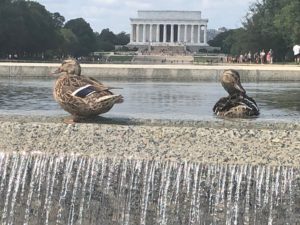
Side Trip to D.C.
This past Labor Day weekend, we took a brief time-out from our Summer of Love in the Heart of the Great American Heartland to visit Bradley and Nicole in their new home in our nation’s capital. They’re spending at least the next year there while Bradley works in the office of our favorite California congressman, Jim Costa. And while the grant that took Brad to Washington, D.C., will end next year, we suspect he and Nicole will enjoy the place so much that they’ll stay.
That kind of startling turn of events makes parents both happy and sad. We are, of course, happy that they are having the times of their lives in a truly great American city. But we are somewhat saddened, as well, because they no longer live close to where we spend most of the year — on the Central Coast of California.
A few weeks ago, while we were processing these feelings in our summer home in Ames, we decided we’d just go to D.C. and visit them. So there we were, jetting into Reagan National Airport this past Saturday night. And there we were, trying to figure out how to use the city’s excellent Metro rail system. It had been years since we’d been there, and at our age, of course, memories often disappear in moments.
 With the help of a kindly airport worker — who had undoubtedly seen our looks of frustration at least a few times before — we managed to buy our passes and get on board the Blue Line. Minutes later, we disembarked at the Capitol South station and found our delightful hotel a block away. It was in a wonderful old neighborhood of colorful row houses, some of which date back to the 1860’s. As I often tell Sharon whenever we travel, “We could live here.” And indeed we could — if only we had the cool $1 million or so it would take to buy one of the smaller three-story units.
With the help of a kindly airport worker — who had undoubtedly seen our looks of frustration at least a few times before — we managed to buy our passes and get on board the Blue Line. Minutes later, we disembarked at the Capitol South station and found our delightful hotel a block away. It was in a wonderful old neighborhood of colorful row houses, some of which date back to the 1860’s. As I often tell Sharon whenever we travel, “We could live here.” And indeed we could — if only we had the cool $1 million or so it would take to buy one of the smaller three-story units.
Visiting D.C. is an exercise in futility, if your goal is to “see everything.” It’s impossible, of course, to see “everything” even if you live there for years. So our goal was to avoid futility and “get real” — what could we actually see and do in the two full days we’d be visiting?
Well, for one thing, we could see the Washington Nationals baseball team beat up the Miami Marlins in a Sunday afternoon game. So we made our way to Nats Park on that warm — but not oppressive — afternoon — met up with Brad and Nicole — and settled into great ground-level seats on the first-base side. And we were rewarded quite nicely when the Nats — who are looking more and more like a team to be reckoned with in the playoffs — smashed four homers to defeat the inept Marlins, 9-3.
But for me, the biggest hit of the game wasn’t Anthony Rendon’s line-drive homer to left that put the Nats ahead for good — it was my stadium lunch. We all bought different things — but when I told the clerk at one of the stadium food booths that I was “really” hungry — he suggested something I’d never heard of. I tried it, and let me tell you, my shawarma was both filling and outstanding. Go ahead, look it up and then find a place where you can get it. I didn’t eat another meal until — well, until dinner late that Sunday night.
We knew we couldn’t see more than a few things during our two-day sojourn — so we picked some oldies but goodies that we’d visited on previous trips. One of them was the National Gallery of Art. No doubt the proper way to see this priceless piece of American property is to spend weeks, and perhaps months, inside. It is, after all, one of the biggest museums in North America, and it contains thousands and thousands of paintings.
 So naturally, when I walked up to one of the front-desk attendants and asked her what we could see “in about an hour,” her look of contempt spoke volumes about what she thought about this particular Ugly American’s cultural awareness. But she dutifully whipped out a brochure and penned in “VG,” “LDV” and “R & V,” at the locations where we could, indeed, find works by Vincent van Gogh, Leonardo da Vinci, Rembrandt and a “V” whom we’ve both forgotten and perhaps never saw.
So naturally, when I walked up to one of the front-desk attendants and asked her what we could see “in about an hour,” her look of contempt spoke volumes about what she thought about this particular Ugly American’s cultural awareness. But she dutifully whipped out a brochure and penned in “VG,” “LDV” and “R & V,” at the locations where we could, indeed, find works by Vincent van Gogh, Leonardo da Vinci, Rembrandt and a “V” whom we’ve both forgotten and perhaps never saw.
So we hustled around the building and saw the “biggies” the front-desk lady had directed us to — in addition, of course, to many of the other notables who share space in that magnificent edifice. Yes, we blew though that art gallery in record time — getting only a miniscule look at what Lies Inside. But at least we had been there.
And then, a few minutes later, we were inside the National Archives. Now, this building houses priceless material that would take weeks to properly assess and enjoy. We gave it a full 15 minutes because all we wanted to see — again, because we’d been there years earlier, as we had in almost every other place we visited — was the Declaration and the Constitution.
And we saw them. The Declaration, I’m sorry to report, has faded to a point where it’s nearly invisible. The Constitution is in much better shape — still readable, 230 years later. It was emotional to see them and realize the power and brilliance behind those writings — and, of course, it was remarkable to know that they are the original documents signed by the men who made this country — not copies, or copies of copies.
 One of our must-stop places on this trip was the World War Two Memorial, which is situated between the Washington Monument and the Lincoln Memorial. Sharon had seen it, but I had not. This being Labor Day, there was a ceremony involving World War Two survivors. There were perhaps 20 of them, all in their 90’s and most unable to navigate without their wheelchairs. These men are the last vestiges of what Tom Brokaw brilliantly called “the Greatest Generation,” and it was sad to know that their ranks are growing thinner by the day. They helped save Our World, and attention should always — always — be paid to their bravery and sacrifice.
One of our must-stop places on this trip was the World War Two Memorial, which is situated between the Washington Monument and the Lincoln Memorial. Sharon had seen it, but I had not. This being Labor Day, there was a ceremony involving World War Two survivors. There were perhaps 20 of them, all in their 90’s and most unable to navigate without their wheelchairs. These men are the last vestiges of what Tom Brokaw brilliantly called “the Greatest Generation,” and it was sad to know that their ranks are growing thinner by the day. They helped save Our World, and attention should always — always — be paid to their bravery and sacrifice.
The Memorial itself is marvelous. It features tall columns for each of the states, and because we spend much time in — and love — both California and Iowa, we found it more than interesting that the column for California is next to the one for Iowa. Gold stars are embedded in one of the memorial’s walls. Each star represents 100 American deaths in the war, and there are more than 4,000 stars. It’s a stunning visual reminder of the horrible costs of war.
 We had walked by the Washington Monument on our way to the World War Two Memorial, but it’s closed for repairs. We did not have time to visit the Lincoln Memorial, but managed to take a nice photo from the war memorial, looking toward Lincoln’s. A small pond was in front of us, and ducks were washing and preening themselves in that pond — oblivious to the large crowds nearby.
We had walked by the Washington Monument on our way to the World War Two Memorial, but it’s closed for repairs. We did not have time to visit the Lincoln Memorial, but managed to take a nice photo from the war memorial, looking toward Lincoln’s. A small pond was in front of us, and ducks were washing and preening themselves in that pond — oblivious to the large crowds nearby.
On our way to the Capitol, we strolled by the White House. The rules of modern life — meaning life dominated by the fear of terrorism — dictate that street approaches to the White House, the Capitol, and many other governmental buildings must be blocked with barricades strong enough to stop any would-be bomber attempting to drive in. I’m not going to say that it’s an unfortunate part of life now — because it’s simply a necessary part of life, now and for however long our nation endures.
Brad and Nicole — who had joined us only for the ballgame and dinner the day before — caught up with us again on Labor Day afternoon for a tour of the Capitol. We had a marvelous, funny guide, who regaled us with story after story about the history of the rooms we were able to see. We learned — or perhaps re-learned, because our last trip to the Capitol had been years before — that the first “home” of the Senate had been in the small room that, a few years later, became the home of the Supreme Court for decades. We walked into the great Capitol Rotunda — the one where you can see the building’s iconic dome from the inside. It’s also the room where dead presidents lie in state. The rotunda is so huge that my camera could not capture anything close to its essence, and its architecture is so detailed that my eyes could not come close to seeing all that is there.
We also went into the great room that houses many of the statues that are on display in the Capitol. That room was once the home of the House of Representatives. Now, of course, both the House and the Senate have their chambers in separate wings in the Capitol.
 We had time for one more “visit,” so we took the underground tunnel from the Capitol to the Library of Congress across the street. Yes, this greatest-of-all repositories for printed works in the United States merits at least a few hours. We managed to squeeze out a full quarter-hour. If that’s all you have — make sure to go, as we did, to the “viewing room” above the main reading area of the library. Spectacular. While we were there, a little boy who was with his parents told us he had seen “this very room” the night before, when he watched the “National Treasure” movie. I told him — and I thought it was a nice, on-the-spot ad-lib — that the room below was the real “national treasure.” His parents liked that, and I think the boy did, too.
We had time for one more “visit,” so we took the underground tunnel from the Capitol to the Library of Congress across the street. Yes, this greatest-of-all repositories for printed works in the United States merits at least a few hours. We managed to squeeze out a full quarter-hour. If that’s all you have — make sure to go, as we did, to the “viewing room” above the main reading area of the library. Spectacular. While we were there, a little boy who was with his parents told us he had seen “this very room” the night before, when he watched the “National Treasure” movie. I told him — and I thought it was a nice, on-the-spot ad-lib — that the room below was the real “national treasure.” His parents liked that, and I think the boy did, too.
After two absolutely whirl-wind days, we hopped on board the Blue Line near our hotel this Tuesday morning and made our way to Reagan National for the non-stop flight back to Des Moines. We left D.C. with a deeper-than-ever appreciation for the city that has so many of our great historical structures and our great documents. We left with a determination to “do this again” next year — perhaps, again, around Labor Day. After all, it’s been years since we’ve been to the National Museum of American History, or to the Air and Space Museum. If we manage our time well, we might be able to squeeze out a good half-hour in each one — leaving us time to perhaps work in a tour of the White House.
But mostly, what we came away with was the clear understanding that Brad and Nicole are starting the greatest adventure of their lives. Sharon and I did much the same thing, at about the same age, when we were making our way through a broadcasting career that took us all over the nation and back. Yes, we will miss seeing them as often as we have. Yes, we are greatly proud of them. And, yes, how we wish we were young, like they are, and on our own career road, again. Because, you see, “We could live there” — in D.C., or wherever else that road would take us, as it once did, so very, very long ago.
